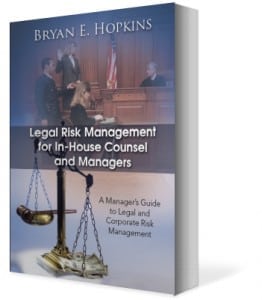 Trade Secrets- Are You Protected?.....We live in a competitive world. The extent to which a company is able to protect its trade secrets is an important factor in its overall ability to survive and prosper. In the employment context, complicated legal issues arise when a departing employee is in a position to use and/or disclose confidential information to a competitor.
Trade Secrets- Are You Protected?.....We live in a competitive world. The extent to which a company is able to protect its trade secrets is an important factor in its overall ability to survive and prosper. In the employment context, complicated legal issues arise when a departing employee is in a position to use and/or disclose confidential information to a competitor. To Save Time and Money Select Your Predispute Strategy Before The Dispute!
In today’s hectic unsympathetic world, little time is spent on dispute resolution strategies prior to the start of a dispute. Little thought is given on how to handle negotiations prior to negotiating. Companies or organizations do not think about arbitration strategies as well as preventive measures prior to initiating arbitration. In fact, very few companies train employees on predispute strategies nor on how to select dispute resolution strategies before the dispute arises.
Selecting a predispute strategy can save time and money. Predispute arbitration or predispute mediation provisions can be used to strategically impact the cost and timing of resolving the dispute. Other contractual provisions can also be used to impact the dispute resolution process such as liquidated damages or attorney fees and costs provisions requiring the loser to pay attorneys’ fees. This is one form of predispute strategy- making it harder or more costly for the other side to prosecute a claim or to defend the dispute resolution strategy. But there are other benefits as well.
Training employees to use pre-dispute resolution strategies not only encourages people to proactively handle disputes- ie resolve the dispute before it occurs, but it forces them to carefully consider the advantages and disadvantages of each form of dispute resolution prior to deciding on which form of dispute resolution to use. Each form of dispute resolution, such as negotiations or mediation (or even litigation) has its merits. And, of course, each form has its disadvantages as well. Spending time carefully considering the strategy before having to implement it allows one to consider various issues such as cost and expense, time considerations, enforcement, applicability and in cases of arbitration or litigation- relevant laws and the forum of the dispute. In some cases negotiations or even use of an ombudsman may be efficient.
Each situation has a certain level of risk and each company or even individual has a certain level of risk tolerance. In fact, a Board of Directors may have a different risk appetite than the management of a company. Selecting a pre dispute strategy helps all relevant parties in the organization or company discuss the risk involved with the various dispute resolution strategies. In this regard, when discussing pre dispute resolution strategies it may be helpful to use a decision tree to map out the various dispute resolution strategies and the risk as well as cost involved.
Disputes arise in many commercial as well as non commercial situations. Some disputes may require litigation some may not. However, the more one is prepared prior to the actual dispute itself, the more efficient and less costly the dispute resolution process may in fact become. Therefore, prior to a dispute arising, select your predispute resolution strategy.
 Arbitration in Korea- A new arbitration hub in Asia
Arbitration in Korea- A new arbitration hub in Asia
Anyone doing business in Korea knows that alternative dispute resolution ( ADR) is gaining popularity in Korea. This is especially true of arbitration which has seen a dramatic increase in the number of arbitration cases over the last few years. (more…)
 Negotiations are an often underutilized Legal Risk Management (LRM) tool. Used as a dispute resolution mechanism, negotiations can be used to resolve disputes, internal and external to a corporation, prior to such disputes turning into litigation. It is another tool to avoid the risk of litigation or arbitration and can minimize legal costs and expenses that might otherwise occur. It can be used to prevent internal discord in an organization and can also be used to resolve differences between governments and political entities besides corporations and companies. In fact, we all use some form of negotiations on a regular basis and our career or life may be determined on how successful we are at negotiating. We negotiate for a raise, for a promotion, for a career, for almost everything in life- sometimes without realizing it.
Negotiations are an often underutilized Legal Risk Management (LRM) tool. Used as a dispute resolution mechanism, negotiations can be used to resolve disputes, internal and external to a corporation, prior to such disputes turning into litigation. It is another tool to avoid the risk of litigation or arbitration and can minimize legal costs and expenses that might otherwise occur. It can be used to prevent internal discord in an organization and can also be used to resolve differences between governments and political entities besides corporations and companies. In fact, we all use some form of negotiations on a regular basis and our career or life may be determined on how successful we are at negotiating. We negotiate for a raise, for a promotion, for a career, for almost everything in life- sometimes without realizing it.
Negotiations can be simple or complex, depending on the subject matter and number of parties involved. International negotiations are the most complex as they involve different cultures, languages, legal systems, and viewpoints. Nonetheless, all negotiations, whether domestic or international, will involve strategies, knowledge of the facts and issues, an understanding of the other side’s viewpoints, and, above all else, an understanding of the problem and risk at hand. To be successful, one has to be “willing” to negotiate.
Negotiation can be defined primarily as a decision-making process whereby two or more parties resolve their disputes or differences by advancing their interests vis-à-vis each other. Negotiations may be broken down into several distinct stages:
All three stages are crucial to successful resolution of a dispute or potential dispute that could lead to the risk of litigation and onerous or excessive legal fees and costs.
1.1 The Pre-Negotiation Stage
Prior to negotiating with the other party or disputant, a party must understand the facts, identify the issues involved, and map out a strategy to deal with negotiations. Though it may seem easy, this stage actually involves numerous steps. Each step may involve several processes or sub-processes as well. The basic steps are as follows:
Knowing your BATNA sets the bottom floor of any deal, as it will set the range of a possible settlement. No party will agree to a negotiation that offers less than the party’s BATNA. By way of example:
BATNA—ABC Company
Tristar wants to enter into a supply contract with ABC Company to sell TVs at 15 percent above margin. ABC wants to purchase TVs at 5 percent above margin. Tristar knows it can sell all of its TVs to Best Bros. Company at 12 percent above margin. Tristar’s BATNA is 12 percent above margin.
Once a party understands the facts, has defined the dispute to be resolved, and knows its BATNA, it needs to develop its negotiation strategy. There are two basic strategies negotiators use in negotiating dispute:
1.1.1 Competitive-Style ( Position-Based) Negotiation
Negotiations maybe conducted in a competitive manner whereby parties state their positions and negotiate from those positions. It is considered a win/lose strategy or position based strategy. It is the most common form of negotiation strategy that everyone is familiar with, though not the most effective, as it focuses only on the negotiating a party’s wants and needs and does not address the needs and wants or desires of the other party. Many people not familiar with negotiating will tend to follow the competitive style approach, which in some situations will not succeed.
1.1.2 Cooperative-Style ( Interest-Based) Negotiation
Negotiations may also be conducted as a cooperative process or interest based process whereby the parties focus on solving each other’s problems and addressing both parties needs and desires. It is, in other words, a win/win strategy or interest based negotiation strategy.
Parties may use one or the other negotiation strategy of win/lose, or both, or hybrids of both if needed. It is common to use both strategies in one negotiation. Using the strategies depends on how parties perceive negotiations and often whether they want a short-term relationship or long-term relationship with the other party.
In many situations, it is imperative to know the BATNA of the other side. This may facilitate negotiations, as the parties may try to solve each other’s problems. Failure to solve your counterpart’s main concerns and issues may lead to failed negotiations. Of course, your counterpart has his or her own BATNA. Here is an example of what companies may face when negotiating:
XYZ Company in Korea wants to distribute product XXX in Thailand. Thailand’s laws prevent direct sales. XYZ wants to find a distributor that can distribute its product XXX. Bainai is willing to become a distributor. It costs $1 million in investment and setup costs to distribute product XXX. To recoup its investment, Bainai wants a five-year exclusive contract. XYZ knows it can find other distributors later, but it needs a distributor now. It does not want to sign an exclusive arrangement with Bainai. What if Bainai is a poor distributor?
Question- What win/win solutions can XYZ and Bainai propose to each other so each can meet its BATNA, or solve each other’s interests? The answer of course is that XYZ and Bainai can agree to an agreement with milestones. If Bainai reaches a certain level of sales after 1 year it can get its exclusive contract for 4 years. If it can’t, its agreement turns into a non-exclusive agreement and XYZ can bring on another distributor. Both sides in effect get what they want.
1.2 Negotiation Stage
The negotiation stage or middle stage of the negotiation process involves numerous decisions too. Once parties have finalized the pre-negotiation stage, decisions still have to be made involving such issues as when, where, and how negotiations will take place.
For instance, parties may start negotiations via e-mail to negotiate minor items before concluding negotiations over the phone. Or they may start negotiations over the phone and wrap up with face-to-face negotiations. Or they may start with using email to negotiate minor items, phone conferences to settle some other items and then meet face to face to conclude the most important items and issues. Therefore, decisions have to be made on how to negotiate to one’s own advantage.
During the negotiation stage, internal and/or external parties and stakeholders may play a part in the outcome. Decisions must be made whether to include them or not. If third parties are involved in negotiations, one or both of the main parties may try to develop coalitions. Third parties may, in fact, add more problems and issues to negotiations or at least bring an added dimension to the discussions.
Parties must also decide upon a venue for negotiations. Many parties prefer a neutral site. However, those negotiators in a strong position may prefer negotiations to be held in their own office. It is all about tactics and to a certain degree perception of the other party’s position.
1.3 Post-negotiation
An equally important stage is the last stage of negotiations or the post-negotiation stage. This stage results in an agreement or resolution. Hopefully an enforceable one at that.
Parties must also decide whether to reduce an agreement to writing or leave it verbal—or a little bit of both. There are several sub- processes in this stage, such as concluding an agreement, drafting it in writing, and having the parties review it and approve it. Of course, each party may need its home office or upper management to approve the agreement as well. Parties may want their respective Law Departments or outside lawyers to review the negotiated agreements. Agreements need to be reviewed to determine if they indeed resolve the dispute, and if the agreements are enforceable.
 In the late 1300s, once the Chosun Dynasty was founded, work began in the new captial of Korea ( Seoul) which inlcuded the building of the inner and outer walls. The inner walls were built through the 4 major mountians surrounding Seoul, inlcuding Mt. Inwang. Because the wall foundations were very well built and because most of the wall was built through the mountains, much of it ( as evidenced by the picture of the wall on Mt. Inwang) still remains. In fact, the Seoul City inner wall, is the longest survivng wall of any major city in the world- relativley untouched by invasions and war. Whether a wall survives the test of time, depends on several factors. The same can be said for corporations. Corporations survive for the long term if the company is properly managed, if the business plan is updated with the times, if the product or service keeps up with demand and of course, if the risk management processes are robust enough to handle the numnerous areas of risk that the company will, most often than not, encounter.
In the late 1300s, once the Chosun Dynasty was founded, work began in the new captial of Korea ( Seoul) which inlcuded the building of the inner and outer walls. The inner walls were built through the 4 major mountians surrounding Seoul, inlcuding Mt. Inwang. Because the wall foundations were very well built and because most of the wall was built through the mountains, much of it ( as evidenced by the picture of the wall on Mt. Inwang) still remains. In fact, the Seoul City inner wall, is the longest survivng wall of any major city in the world- relativley untouched by invasions and war. Whether a wall survives the test of time, depends on several factors. The same can be said for corporations. Corporations survive for the long term if the company is properly managed, if the business plan is updated with the times, if the product or service keeps up with demand and of course, if the risk management processes are robust enough to handle the numnerous areas of risk that the company will, most often than not, encounter.
Have you looked at your risk management processes lately? How robust are they? How strong are they? Have they stood the test of time like the wall on Mt. Inhwang, or are they outdated like some of the processes used by investment banks in 2008?
When considering which processes to use or update, remember to conduct periodic risk assessments that monitor the effectiveness of the risk management processes. Only through a process of continuous risk assessments can a company effectively manage risk by identifying weaknesses in the system, which helps it to effectively maintain a robust risk management program.
What steps has your organization taken recently to conduct a comprehensive risk management program? Has it reviewed all critical corporate processes and procedures? When evaluating risk assessments in order to minimize risk, especially legal risk, specific goals or objectives should be established in which to judge the risk assessments that have been completed. What are the goals or objectives, if any, that have been established? When determining the objectives to evaluate risks, what specific processes or tools are in place to obtain those objectives? All of these questions must be answered.
Remember, legal risk management processes must be properly applied in order to provide risk management expertise and to prevent losses due to claims, litigation, investigations and fines. Such processes should include:
1. A periodic risk assessment of the company's operating divisions and departments,
2. The development of solutions to risk management issues,
3. Oversight of the company's outstanding claims and litigation,
4. Compliance review,
5. Training programs, and
6. Monitoring of compliance issues
Only with a proper implementation of a robust risk managment process can a company expect, with all things considered, to last like the Seoul City Wall on Mt. Inwang. Without it, the company like a wall , may come tumbling down.
In managing ERISA claims dont forget your fiduciary duty!
NOTE: One of the most important audits a risk manager/in-house counsel should conduct as part of a risk managment program is an audit of employee benefit plans. Many countries offer employee benefit plans, pensions, or related schemes in accordance with local laws. In the U.S., employee benefit plans or retirement benefit plans are subject to the requirements of the Employee Retirement Income Security Act of 1974, as amended (ERISA).
For subsidiaries of foreign owned companies doing business in the U.S. or even for US based companies, it is very important, for reasons set forth below that a risk management program cover an ERISA audit as well as a compliance review. Failure to do so, could subject a company in the U.S. as well as the company’s board of directors ( BOD) to $$$ in fines and penalties, not only from the Department of Labor’s standpoint but from the I.R.S. standpoint as well. Therefore, either the in-house counsel or the risk management department must conduct the audit. As most companies have HR coordinating employee benefit plans, I would not have HR conduct the audit. The audit should be conducted impartially.
Regulations adopted pursuant to ERISA set fort requirements respecting employee retirement and welfare benefit plans (the “Plan”), include:
ERISA requires that health and welfare plans be set forth in a written document which describes the benefit and the operation of the Plan. The document must identify who is responsible for the control, management and operation of the Plan. The Plan must also have recordkeeping systems to track the flow of funds and written. Materials to provide to Plan participants.
The general review of a compliance audit should focus on three areas:
ERISA sets standards of conduct for employee benefit plan sponsors and others who exercise discretion in managing a plan or plan assets. Therefore, use of discretion in administering and managing an employee benefit plan or controlling the plan’s assets makes that person a fiduciary to the extent of such control or discretion. Fiduciary status is determined based upon the functions performed. Each Plan must have a named fiduciary; however, a person does not need to be named to be a fiduciary; who jointly or severally control and manage the operation and administration of the Plan. The Plan instrument may actually designate the named fiduciary or may specify a procedure for naming the fiduciary by the employer.
ERISA sets forth the standards and rules of conduct for plan fiduciaries. Plan fiduciaries are required under ERISA to fulfill a number of duties including:
A fiduciary who breaches any responsibility or duty under ERISA may be personally liable to make good any losses to the Plan resulting from the breach. All fiduciaries have potential liability for the actions of their co-fiduciaries. Breaches of fiduciary responsibility can give rise to civil and criminal penalties, which can be enormous. This has been opened by the U.S Supreme Court. The U.S. Supreme Court has held that individual employee may bring an action for “appropriate equitable relief” under ERISA against an employer for breaching its fiduciary duties. And recently, the US Supreme Court ruled that plan administrators must continue to monitor trust investments and remove imprudent ones. This is a continuing duty which is seperate from the duty to exercise prudence in selecting investments from the beginning. In order to properly follow principles as plan administrators the US Supreme Court therefore ruled that plan administrators must act with "skill, prudence, and diligence" and if not- they have breached their fiduciary duty!
Remember, it is cucial that subsidiaries of foreign owned companies doing business in the US that have employee benefit plans inlcuding 401 K plans follow ERISA regulations thoroughly and that their respective BODs fullfill their fiduciary duites properly. It is also important to recognize where the company’s board is acting in a fiduciary capacity or on behalf of the employer in a non-fiduciary capacity. If the BOD fails to act prudently in a fiduciary capacity it and/or the company is exposed to claims worth $$$$ millions of dollars. Just ask Lockheed Martin, Boeing, or Edison International.